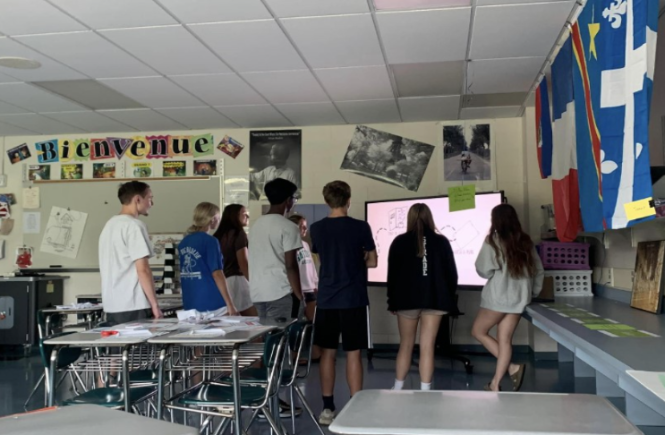Welcoming a New Perspective
I go to Allegany-Limestone a school that a majority of listeners may have never heard of. It is a small school in Western New York.

A group of student council members at Allegany-Limestone Highschool meet to discuss their vision for what accurate representation and school spirit should look like for the upcoming school year.
I first learned of the DemocracyReady NY celebration of Civic Learning Week through an email forwarded by my superintendent dad. My dad and mom are both superintendents. Twenty-four hours a day, I am surrounded by educators, but yet I have never felt like I’ve carried much influence over them. As I read deeper into the opportunity, it seemed incredibly compelling, I could talk to my policymakers directly. Not through a secretary or email, but to them directly.
Each meeting, the fellow organizers and I would address the problems that we were facing, or that we recognized others were facing in the education system. There were a lot. The thought of such a broad subject, educational equity, needing to be summarized in less than two hours seemed daunting, or confining, but with the other organizers the task proved to be possible after all. I owe the success and the liberating feeling I felt after the event to my fellow organizers. Brainstorming is a powerful tool but collaboration became even more efficient, as the other organizers and I discovered that we were all from different parts of New York.
The Tiktok sound “Are you from New York even”? constantly played in my head as I wrapped up a Civic Youth Learning event meeting. Whenever I’m traveling and I’m asked where I’m from, I reply New York, and the response is usually “oh you’re from the city?” Unfortunately, no. I am a student from Allegany, New York, a place I’m sure few to none reading this have ever heard of. Despite the fact that it is a nine-hour drive from the city, I found myself recounting my educational experiences with those of the city, attempting to find common ground.
A majority of my fellow organizers were from New York City. Each of them shared similar experiences with one another. Even Chancellor Young, the head of the Board of Regents seemed to resonate more with the other organizers, owing home base to New York City. In New York City, there are community boards, while where I live, there are school boards. In New York City, kids take the metro to class while kids in my area drive pick up trucks to school.
I simply couldn't understand how educational decisions for the state of New York were made when New York City seemed to be in its own state in entirety. So, I asked.
Here’s how my conversation with Chancellor Young went:
I go to Allegany-Limestone a school that a majority of listeners may have never heard of. It is a small school in Western New York. Most of the participants and my fellow organizers are from New York City. Earlier you mentioned reviewing New York State Learning Standards to ensure all students are granted access to the same material. What are other ways you balance the need for standardization in education where everyone has to be on the same level of knowledge but the importance of allowing for local control and flexibility?
After my question, Chancellor Young shared his main takeaway followed with support:
Let’s build education systems that are more accommodating to a wider range of diverse behaviors
- Difference is not deficient. Chancellor Young promotes professional educators to create an in-sync learning environment where they recognize how their students learn, grow, and develop. It is important for teachers to care about their students. There, they can base their material off of that.
- A standard. Difference is ok, but there has to be a standard for the body of knowledge we want all young people to learn. However, the standard does not have to be sought out through standardized tests. Standards and expectations can be placed into the curriculum and content of schools.
- Personalization. Schools need to meet the needs of a student. Becoming applicable in reading, writing, and math classes is necessary, but Chancellor Young preaches that schools should also meet the hopes and aspirations of students.
Education is not supposed to be equal. It is supposed to be equitable. Coming from a distinct part of New York, I was able to offer a different point of view. However, with more thought, every district of New York City appeared to be different as well. Queens is not the same as Brooklyn, and Brooklyn is not the same as Manhattan. So, the question stumped me again “How is he or she getting the same education as me?”.
The outcome of education revolves around the community. The community’s beliefs can be expressed through a board, parents, taxpayers, and most importantly-students.
With DemocracyReady NY, having an outlet to express academic experiences finally solved my initial dilemma- “How can I compare to these New York City kids?” The answer was, I couldn’t. Each educational experience is different and it is not educational equality that we must strive for but educational equity. Every student must be provided the tools they need to succeed, but local control and flexibility should be factored in. Within your community you can inspire change, and express your preferred way of learning. All it takes is voice.